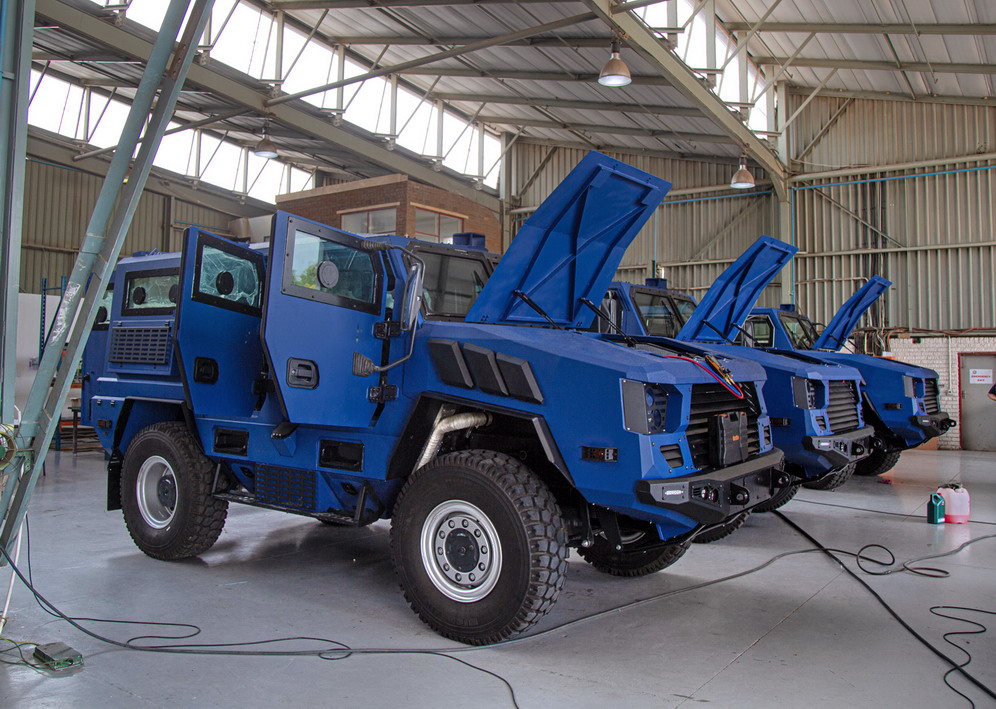Paramount Maatla vehicles being assembled.
South Africa’s long struggling defence industry has, in recent years, experienced somewhat of a revival. The National Conventional Arms Control Committee’s (NCACC’s) annual reports have shown that the country’s arms exports have grown yearly since 2020, with the NCACC’s 2023 annual report indicating the near doubling of exports year on year. What is particularly notable is that the industry appears to be showing significant growth in both old and new markets.
Trends in South African Arms Exports
South African defence exports have experienced growth in general: the major sources of growth can largely be ascribed to ammunition exports and to a lesser extent armoured combat vehicles as well as electronic warfare equipment. This is largely in line with global trends, with demand for munition – 155 mm shells in particular – growing significantly since the start of the Russian invasion of Ukraine in early 2022, with the Stockholm International Peace Research Institute (SIPRI) reporting that global military spending rose to $2 443 billion in 2023, “the highest level ever recorded by SIPRI.”
While the state-owned arms manufacturer Denel appears to have somewhat stabilised, the majority of South Africa’s export growth can be attributed to the private sector with companies such as Paramount Group and Rheinmetall Denel Munition (RDM) expanding their production capabilities to keep up with the growth in international demand. This includes Rheinmetall’s decision to acquire a majority stake in the South African firm Resonant which is a “specialist in plant engineering for chemical applications.” Rheinmetall described this decision as a “response to the growing global demand in the ammunition sector and the resulting customer requirements for the construction of corresponding production facilities.”
Europe Remains a Key Market
Europe has been and remains a primary export destination for South African produced arms is due to a range of factors such as the fact that South African arms conform to NATO standards and the significant increase in European military spending since 2022. According to SIPRI, Central and Western European military spending has increased by some 10 percent between 2022 and 2023 while Eastern European countries have increased spending by approximately 31 precent during the same time period.
This being said, the primary South African export remains various types of ammunition such as Rheinmetall Denel Munitions’ 155 mm Assegai artillery ammunition as well as mortar bombs, with Germany, Estonia and Hungary all placing major orders since 2022.
Notably, in 2023 orders from Hungary and Germany represented some 24 and 26 percent of South Africa’s arms exports with Europe as a whole representing some 56% of South African arms export licences approved in 2023 by the NCACC.
Data Source: NCACC 2023 Annual report
Strong Growth in the African and Emerging Markets
South African defence firms have also increasingly focused their export efforts on the African and other emerging markets to drive their revenue. While neighbouring states such as Mozambique remain regular customers, defence firms such as Paramount Group and DCD Protected Mobility have been experiencing success in exporting to other African states
Unlike the European market, South African exports in Africa have largely been dominated by the export of military vehicles, such as Paramount Maatlas to Ghana, while DCD has experienced particular success through the export of their Springbok range of armoured personnel carriers and Husky mine clearance vehicles, with Côte d’Ivoire in particular placing orders exceeding R500 million recent years.
The most current figures available indicate that Africa represented some 20 percent of South Africa’s defence exports in 2023. Africa has evidently emerged as key source of growth and revenue for the South African defence industry. Other emerging markets in Asia, Oceania, and the Middle East represented approximately one quarter of South Africa’s arms exports in 2023.
Middle East Demand Still Strong
While sales to Middle Eastern countries such as the United Arab Emirates (UAE) and Saudi Arabia were lower in 2023 when compared to previous years, South African firms continue to export significant amounts of arms to the region. While the Middle East and North Africa represented approximately 8% of South African arms exports in 2023, the region represented well over a quarter of South African arms exports between 2018 and 2022, according to the various annual reports released by the NCACC.
The primary export markets for South African arms in the region remain the UAE and Saudi Arabia with orders totalling just under R5 billion between 2018 and 2023 between the two of them. More recently, Türkiye has emerged as an increasingly prominent importer of South African arms, ordering some R377 million worth of arms in 2023 alone.
Additionally, the Middle East remains a key market for some of South Africa’s more advance weapons systems. These range from artillery systems such as the G6 self-propelled howitzer to imaging and countermeasures equipment. It is important to note that the 2023 decline of exports to the Middle East, proportionally and in real terms, is likely reflective of cyclical pressures as similar year on year declines can be observed over the past decade.
Although the South African defence industry remains a shadow of its former self, recently the industry has, because of a range of factors, begun to see a significant uptick in its fortunes. From renewed European demand to expansion in emerging markets, the industry seems to be healthier than it has been in recent times.




